So, you wanna learn how to play drums. Maybe it’s a childhood dream you never chased. Maybe it’s a midlife crisis with rhythm. Or maybe you saw cool Travis Barker spin sticks like a ninja and got inspired.
Wherever you’re starting from zero knowledge, air-drumming in traffic, or bored of tapping your desk at work, this is your no-BS guide.
Let’s make one thing clear: this isn’t a sugar-coated “drums are easy!” pep talk. Drums are fun. Drums are primal. But drums are also technical, physical, and unforgiving when you don’t learn things properly from the start.
Which is why, if you’re serious about this, or even just drum-curious, you need guidance that’s clear, honest, and immediately useful.
And that’s what this guide is. Written by someone who’s played, taught, toured, and sweated over snares across LA for over two decades.
I’ve taught students in Santa Monica, West Hollywood, Glendale, and all the way out to the Valley—every age, every level, every dream. You’ll get insights straight from that experience, and yes, even the mistakes I’ve watched hundreds of students make in their first few months. Spoiler: don’t be the death-grip stick choker. We’ll get there.
Let’s Get This Out of the Way: Drums Aren’t Just “Banging Stuff”
People love to romanticize drums. It’s visceral. Loud. Cool. Cathartic. That’s all true. But rhythm is deeper: drums connect to something hardwired in humans. It’s primal.
Long before guitars or synths, people hit sticks on logs, and others moved their bodies to it. Melody makes you listen. Rhythm makes you move. Picture an acoustic set at a coffee shop. Chill, background vibes. Now add a cajón or a kick/snare groove.
Suddenly, heads nod, feet tap, the whole room wakes up. That’s the power of drums: they don’t just fill space, they flip a switch in people that says, dance.
But underneath every thunderous fill and perfect groove, there’s structure. There’s technique. There’s science. You can “bang stuff” all day and still suck at drumming.
So if you want to actually get better—not just make noise—start by learning how the gear works and how your body interacts with it.
The Kit: Acoustic vs Electronic (Pick Your Poison)
Your first decision is simple but annoying: Do you get an acoustic drum kit or an electronic one? I’ve had this conversation with every beginner student and their parent/spouse/neighbors 100 times. Here’s the reality.
Acoustic kits give you authentic tone, real physical feedback, and the kind of raw, soul-punching experience you see on stage. But they are loud. Like “cops called at 6pm” loud. If you live in an apartment or have thin walls, your neighbors will either hate you or want to jam with you. Unlikely, but possible.
Electronic kits let you plug in headphones and practice quietly.
An e-kit comes with tools built in that you’d normally have to pay extra for: a built-in metronome for timing improvement, recording/playback features to hear progress, USB/MIDI connectivity for more interactive learning and music production, volume adjustability, and software connectivity that supports structured learning.
And if you’re a parent reading this. Yes, they’re an investment up front, but you’ll actually save money in the long run. Why? You don’t need to constantly replace drum heads, broken sticks from over-hitting, or soundproofing solutions for your home.
A well-chosen e-kit grows with the student, from beginner basics to advanced play, without requiring major upgrades right away.
But they won’t feel quite like acoustic drums. You’ll sacrifice some rebound and realism unless you buy a high-end mesh-head kit (which can get pricey fast).
So here’s the call: if you’ve got space and no noise restrictions, go acoustic. If you live in LA like the rest of us, aka sardine-style apartments, go electronic. Don’t overthink it. The fundamentals are the same on both. I’ve trained beginners on $300 e-kits who now play gigs on vintage Ludwig acoustics. The kit isn’t the issue. Your practice is.
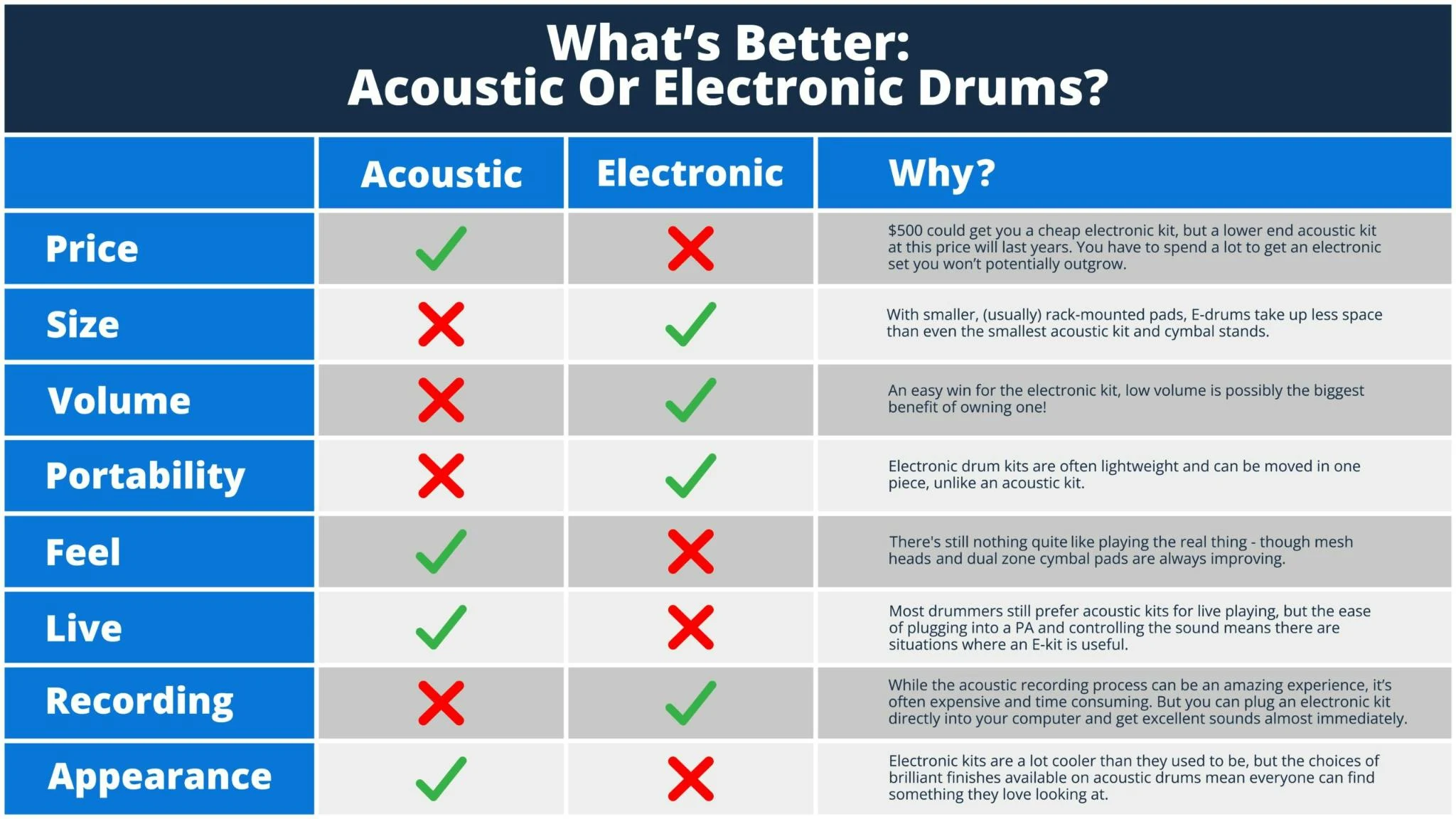
Oh, and if you’re already thinking, “Should I just get a teacher?” Yes, you probably should. Especially if you’re here in LA, we offer some of the best private drum lessons in Los Angeles at Angeles Academy of Music. I’ll tell you more about that later.
How to Hold Drum Sticks (Without Destroying Your Wrists or Dignity)
Let’s fix one thing that ruins most beginner drummers while learning how to play drum kit: bad grip. Holding drumsticks wrong doesn’t just sound bad. It sets you up for injury. Tendonitis is real, and I’ve seen it knock drummers out of action for months.
Here’s what matters: your grip needs to allow the stick to rebound naturally. Think “guiding” the stick, not gripping it like Thor’s hammer.
The matched grip is your go-to. Drop your hands by your side, let them relax, then bring them up in front of you; however your hands fall, that’s your natural grip position.
Place the stick so it rests between your thumb and index finger; this is your fulcrum, the balance point. Your other fingers gently cradle the stick.
Now, let’s talk traditional grip—the old-school cousin of matched grip. Common in jazz and marching bands, the left hand holds the stick differently: angled across the palm, guided by the fingers underneath.
It began with side-mounted marching drums, where matched grip didn’t work. Today, it’s mainly about feel. Traditional grip gives finesse for jazz and ghost notes, but matched grip is stronger for rock and modern styles.
Start with matched grip, then explore traditional if you dive into jazz or study at a school that teaches both.
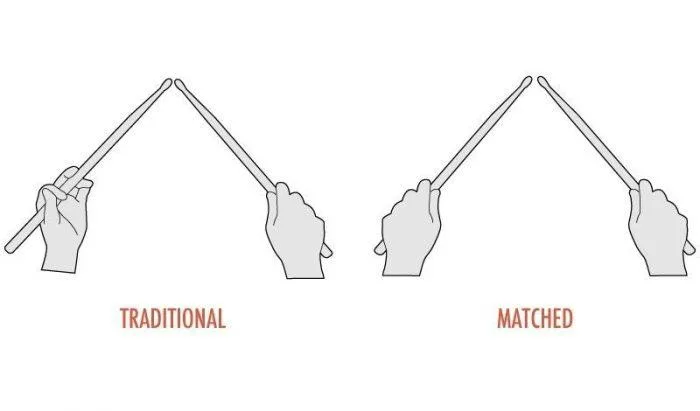
The motion comes from your wrist, not your forearm. If it feels awkward, you’re probably choking it too hard. Let the stick breathe. Let it work for you. You’re not trying to force sound; you’re trying to let the drum do its job.
If you’ve ever wondered why your rolls sound like trash or why your hands fatigue in five minutes, it’s probably because you’re fighting the stick instead of letting it rebound. Fix this now, or regret it later.
Another thing to check is where you’re holding the stick. Too low and you’ll have rebound but almost no control, and you’ll be dropping sticks every other song.
Too high and you kill the bounce, plus you’ll struggle to reach cymbals or drums further out in the setup. The sweet spot is somewhere in between, with a little bit of stick showing past your hand so it feels balanced.
Your thumb and index finger should form the fulcrum (that balance point), while the other fingers lightly cradle the stick. Think of your thumb as guiding, not clamping, and your fingers as shock absorbers that help the stick move naturally.
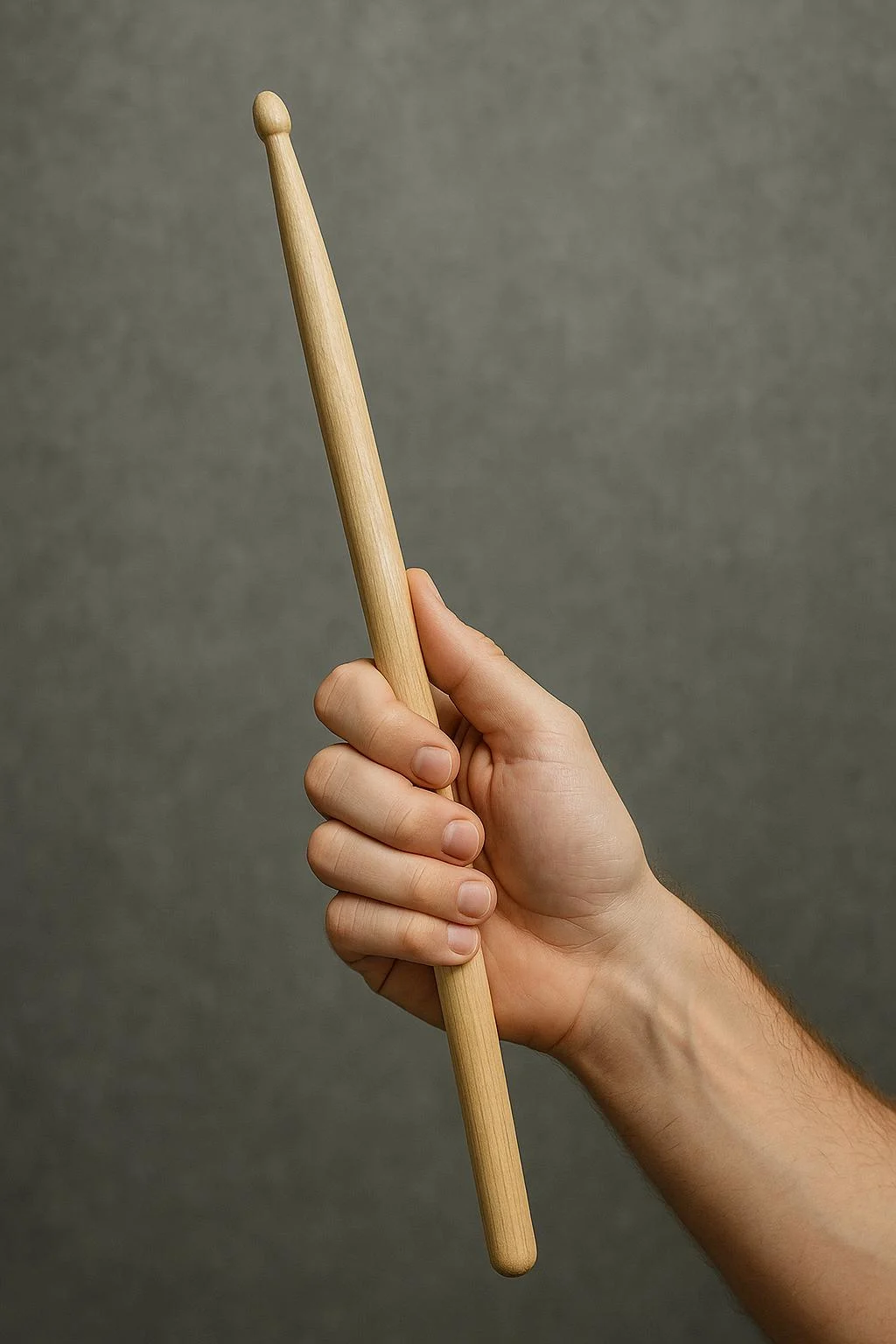
Want a deeper dive into technique? Check out our Top Rated Drum Lessons Los Angeles article to understand why private instruction can save you months of trial and error.
Your First Groove (And Why You Should Stop Overthinking It)
Let’s cut the nonsense: you may learn your first beat in 10 minutes, or it may take a few sessions. We have seen some students pick up really fast, and others, often younger students, get overwhelmed by the information thrown at them. None of the cases is better or worse. Every learner is different, and we respect that at Angeles Academy of Music.
That doesn’t make one student more or less talented, as talent is discovered and nurtured/built with consistent practice. That being said, it’s possible to learn a song like White Stripe in under 10 minutes in your first class.
The foundation of drumming isn’t speed or flair. It’s timing and consistency. Which means if you can count to four, you can play a basic rock beat.
Here’s what you do. Keep your right hand on the hi-hat, playing steady eighth notes: “1 and 2 and 3 and 4 and.” Snare drum on beats 2 and 4. Bass drum on beats 1 and 3. That’s it. It’s the same groove behind hundreds of hit songs, from AC/DC to Adele.
And it’s not about flash. It’s about groove.
Here’s what most beginners screw up: they rush, they overthink, and they forget the beat is supposed to feel good. Play slowly. Stay loose. Let it settle in your body before speeding up. And don’t even think about fills until you can loop that groove for two minutes without derailing.
One of my students once said, “I played a fill and ruined the vibe.” Don’t be that drummer. Groove first. Flash later.
Warm-Ups, Rudiments, and How to Actually Build Control
Here’s a brutal truth: you don’t get faster by playing fast. You get faster by building control at slow speeds. And the only way to build control is to warm up—every. single. time.
You’d be amazed how many beginners skip this step and then wonder why their hands feel like bricks by minute ten. Warm-ups aren’t optional. They’re maintenance. They’re how you build coordination, avoid injury, and actually play cleaner.
Start with single strokes. Put on a metronome at 60 BPM. Play 16th notes (that’s four strokes per click). Alternate R L R L. Do it for five minutes straight. If it gets boring, good—it means you're focusing.
Then switch to double strokes (RRLL). Let the stick bounce. Don’t force it. If your doubles sound like machine gun chaos, slow down. Then go to paradiddles (R L R R / L R L L). This rudiment is a brain twister at first, but it’s pure gold for unlocking coordination.
Now the key: move those rudiments around the kit. Two strokes on snare, two on rack tom, two on floor tom. Repeat. This forces you to adjust spacing, height, and rebound—stuff you won’t learn from just hammering the snare.
Finally, mix in your feet. Keep quarter notes on the bass drum. Now you’ve got real hand-foot independence training. If you can’t do this clean at 60 BPM, don’t even bother pushing to 120. It’s not speed you need. It’s accuracy.
And in case you’re wondering how to properly drum roll, look, this isn’t rocket science, but it’s not a caveman bash either. Your drum roll is usually a double stroke roll. Let each stick bounce naturally. The challenge is making the volume and spacing even. You want a continuous, smooth sound. If it sounds like popcorn, slow it down. Rebound is your friend. Death grip is not.
Practicing Smarter, Not Louder (And How to Remove Drums From a Song)
Here’s something you probably didn’t know you needed: the ability to remove drum tracks from songs. Why? Because playing along to drumless tracks trains your timing like nothing else. No crutches. No safety net. Just you and the groove.
How to Remove Drum Tracks from Songs?
Apps like LALAL.AI, Moises.ai, PhonicMind, or Splitter help you isolate or mute the drum track. Just upload a song from your library or a public link, choose track separation, and let the app process it.
These tools are scary good now. You can then mute or isolate drums, adjust their volumes, change tempo or key, view real-time chords, and practice or create covers seamlessly.
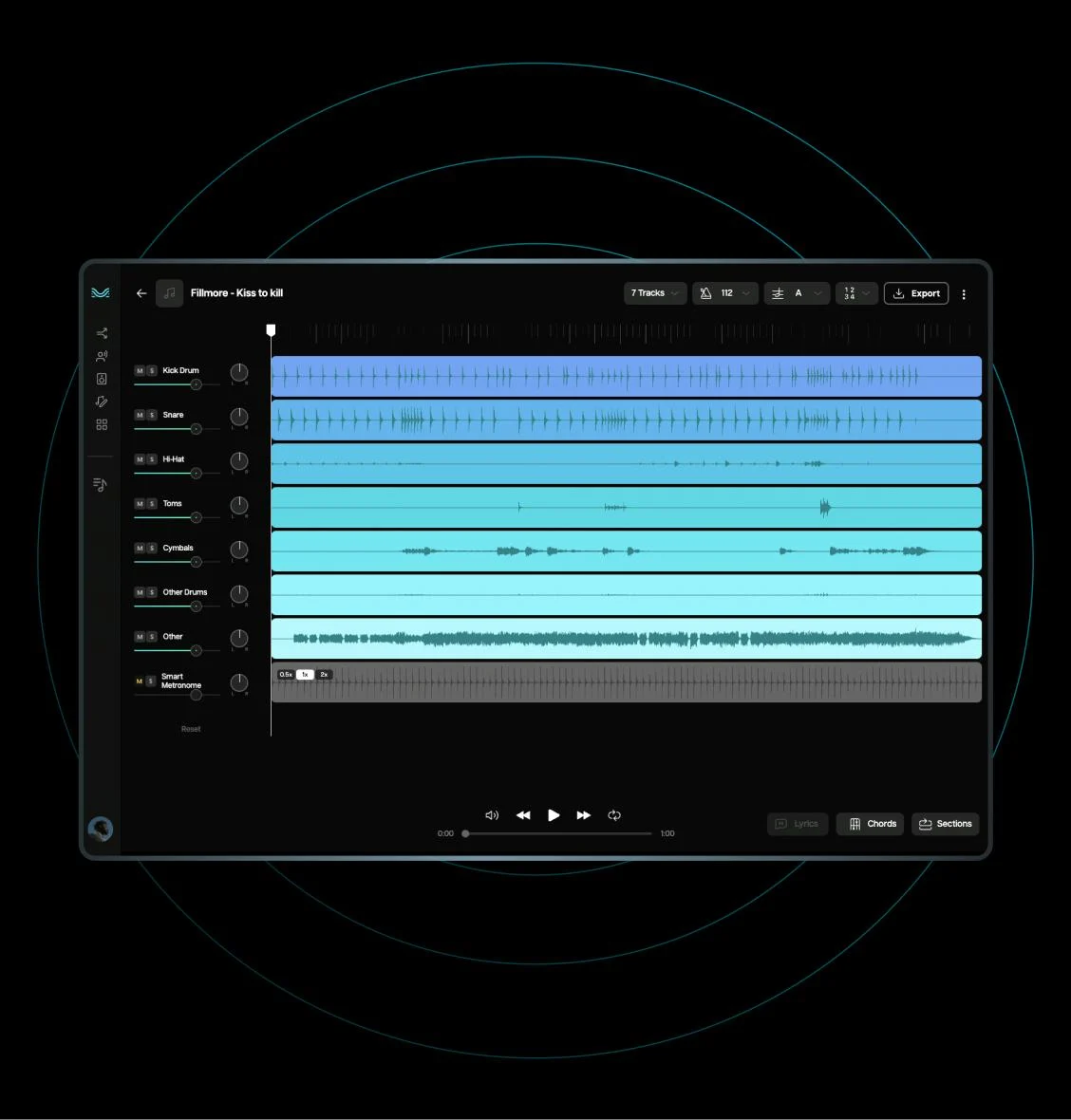
Upload any song, and boom, you’re playing the drummer’s part, not with it. Suddenly, your timing flaws are exposed. Perfect.
Alternatively, search YouTube for “drumless backing tracks” in your favorite genre. These are pre-made play-alongs with no drums, often with click tracks built in. I assign these to students all the time. They love it. Then they hate it. Then they get better.
Now let’s talk quiet practice. If you need to know how to practice drums without a kit, use a pillow (for no rebound training), or a rubber pad (for realistic stick feel). For the feet, tap with your heel and toe on the floor, or use a pedal on a pad. Air-drum full grooves while listening to tracks. This wires your brain to the motions—even if you’re just miming.
If you’re using an electronic drum kit, play with headphones and track your practice time. Most e-kits have built-in coaching tools. Use them. They’ll force you to stay in time and highlight where you’re drifting. Treat your e-kit like a lab, not a toy.
If you’re still stuck on the “should I get lessons?” question, yes. Book a few. It doesn’t have to be forever. But even two or three private drum lessons near me can save you from months of confusion, bad habits, and YouTube rabbit holes.
You can start with Angeles Academy’s drum program, try a trial lesson, and learn how to play the drums from the best. Worst case? You learn something. Best case? You actually level up fast.
How to Practice Drums Without a Kit (Because Life Isn’t Fair)
Let’s say you don’t have a kit yet. Good. You’re in the perfect spot to develop real discipline. Because here’s the truth: you don’t need drums to learn how to play drums. Seriously. You can build 80% of your skills without ever touching a tom.
That’s not just motivational fluff. That’s physics and neuroplasticity. So, how to practice drums without a drum set?
Practicing rudiments on a pillow or pad trains your muscles. Listening to rhythms and clapping them develops your internal timing. Air-drumming to song wire coordination. Couch cushions and pizza boxes? Those are valid training tools.
Even just playing on your knees with your hands can build coordination. Treat your right hand as the cymbal, your left hand as the snare, and tap your foot as the kick drum. It’s simple, but it trains your brain to link all three parts together.
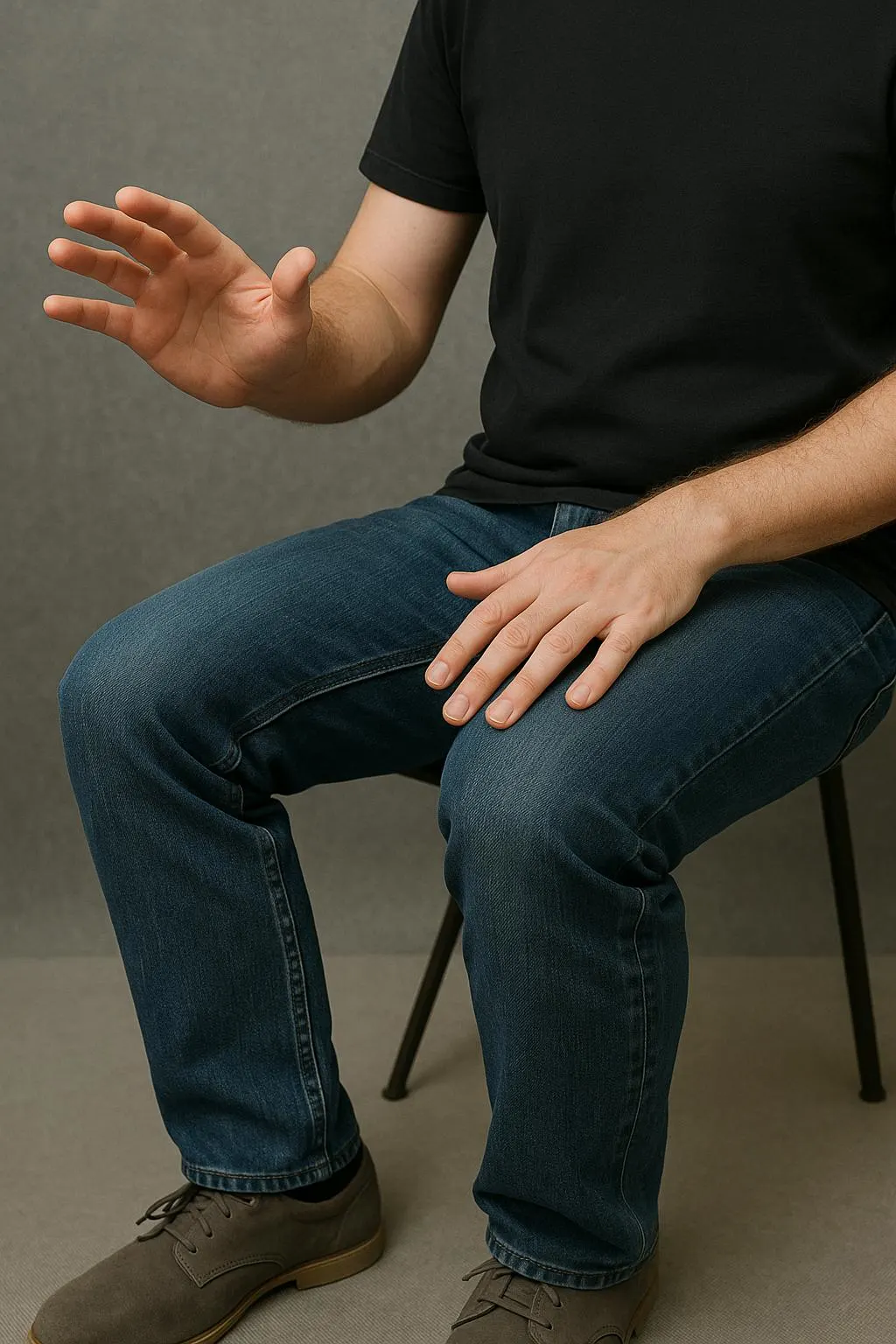
If you want to practice drums without a drum set, start with a metronome, a pair of sticks, and a practice pad. Do single strokes (RLRL), doubles (RRLL), and paradiddles (RLRR LRLL).
Focus on even spacing and consistent sound. Add foot tapping to simulate your bass drum. Then build coordination. Don’t cheat this phase. When you finally sit behind a real kit, everything you practiced will click.
And for the love of rhythm, always use a metronome. If you don’t have a click going while you practice, you’re just guessing your timing. Don’t guess. Be precise.
Common Mistakes That Will Haunt You (Unless You Fix Them Now)
Let’s rip through the usual suspects. First: tension. If your hands, arms, or shoulders are tight, you’re doing it wrong. Drumming should look and feel relaxed. Not like you’re battling the drum set for dominance.
Second: skipping the metronome. I don’t care how “musical” you think your feel is. If you’re not practicing with a click, you’re playing out of time. Period.
Third: too many fills. Don’t be the beginner who drops a fill every four bars like they’re allergic to groove. Nobody wants that. You earn the right to fill after you prove you can hold the beat for five straight minutes without glitching.
Fourth: bad posture. Sit too high, and you lose power. Sit too low, and you wreck your back. Feet flat, back straight, kit within reach. Don’t be a hunchback drummer.
Fifth: gear obsession. It’s not the cymbals. It’s not the sticks. It’s not the snare. It’s your hands. Focus on that.
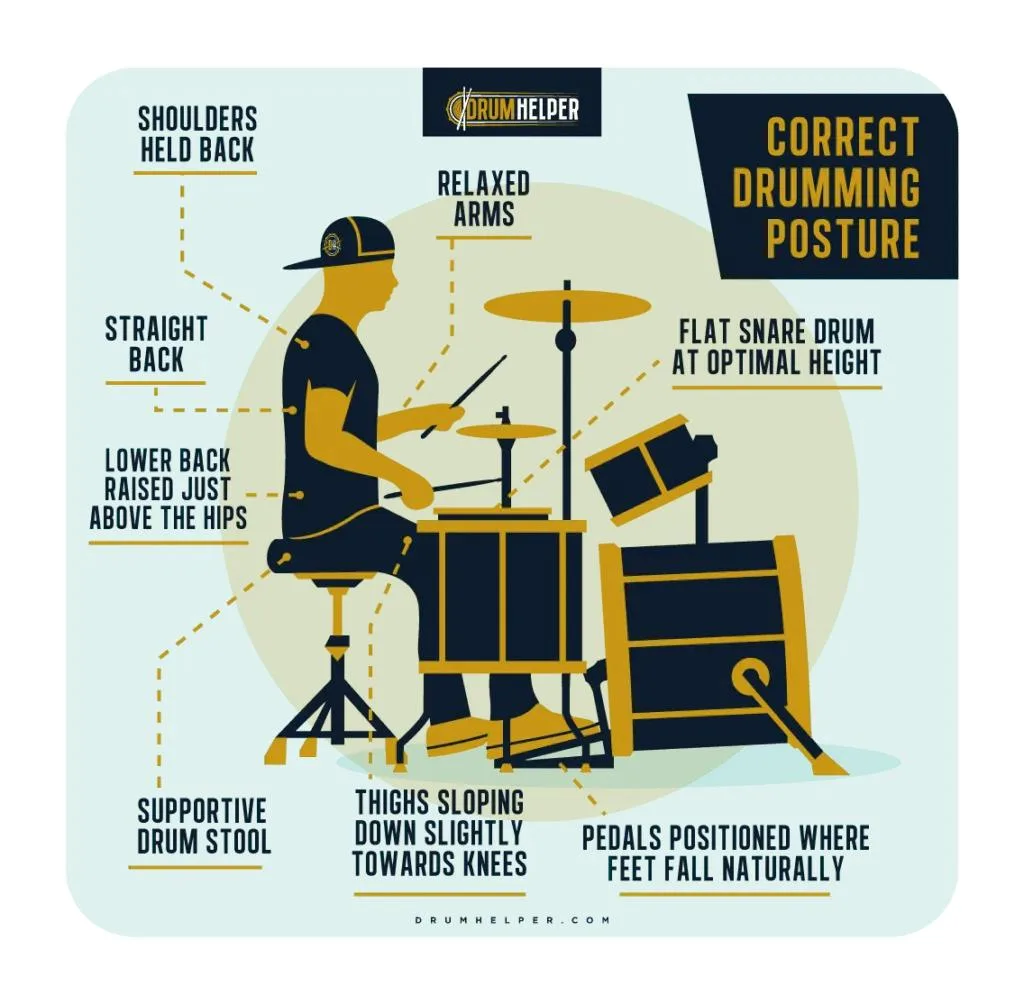
Sixth: avoiding lessons. I get it—YouTube is free, and you’re independent. But there’s a reason even pro athletes have coaches. Sometimes you need someone to call you out on the nonsense and make you better.
Rapid-Fire Q&A: Everything You’re Thinking, Answered
How do you teach yourself to play the drums?
You practice consistently, start slow, use a metronome, and follow structured lessons (online or in books). But more importantly, you record yourself and critique honestly. Self-taught doesn’t mean no feedback.
Use videos for helpful double-checking while learning, especially from trusted sources. Channels like Drumeo on YouTube break down pro drummers in detail.
It means you have to become your own worst critic. Combine that with drumless play-alongs and regular warm-ups, and yeah, you can teach yourself up to an intermediate level. But if you want to skip years of trial and error, get a real teacher.
Are drums easy to play?
No, but they’re addicting. Anyone can play a simple beat in 10 minutes. But real control, dynamics, and groove? That takes time. The drums are deceptively simple. The beat is just the tip. The iceberg is timing, touch, tone, and taste.
What is the 80/20 rule in drumming?
It means 80% of your improvement comes from 20% of your practice—if you’re practicing the right things. Want the shortcut? Spend 80% of your time on timing, hand technique, and groove. Everything else: fills, chops, weird meters, is garnish. Nail the meat and potatoes first.
Can I learn drums in 1 month?
Yes, if your goal is to play one or two basic grooves. No, if you think you’ll be playing Dream Theater by next Friday. One month is enough to build a foundation. Then the real journey begins.
Are drums easier than guitar?
They’re different beasts. Drums require coordination across four limbs. Guitar requires chord shapes and finger strength. Drums give you results faster, but guitar lets you be a one-man band. Pick your poison. But if you ask me, hitting stuff wins.
Can I learn drumming on my own?
Yes, but only if you’re obsessively disciplined and brutally honest. You’ll need structure, feedback (even if self-recorded), and a plan. I’ve seen great self-taught drummers, but they all had one thing in common: they didn’t wing it.
One thing to watch out for: in a world of YouTube and self-proclaimed “experts,” not all content is created equal. A lot of online videos exist because creators have to post something to get views, not because they’re invested in your progress.
That means you risk picking up bad habits or incomplete techniques that a real teacher would never let slide. The incentive online is clicks, not teaching, and that can leave you stuck or learning the wrong way.
That said, you can absolutely train your ear on your own. Practice listening to different parts of the drums separately—hi-hat, snare, kick—until you can follow each layer in a song. This kind of subconscious listening builds independence and groove awareness.
But with lessons, you’ll go further: teachers help you develop the ear to hear subtle differences between grooves and parts of the kit, so you’re not just listening, you’re understanding.
Don’t Just Hit Drums. Play Music.
So now you know how to play the drums, at least the right way to start. And let’s be honest: the world needs more good drummers. Not more blast beat bros. Not more cymbal smashers. But musicians who listen, lock in, and make people move.
If you’re in Los Angeles, stop overthinking and take a real lesson. Our drum instructors at Angeles Academy are actual working musicians who know how to get you results. Whether you’re 8 or 48, brand new or picking it up after years away, we’ll meet you where you’re at, and take you where you want to go.
This isn’t just about drums. It’s about rhythm, discipline, expression, and joy. You’re not learning how to hit things. You’re learning how to say something without words.
Book your private drum lessons in Los Angeles today and get started the right way:
👉 Angeles Academy Drum Program
Contributed by: Jonathan B., Senior Percussion Instructor at Angeles Academy of Music (Bachelors of Music, Musicians Institute; Associate of Arts, Suffolk College.)
.svg)
.svg)
.svg)
.svg)
.svg)
.svg)


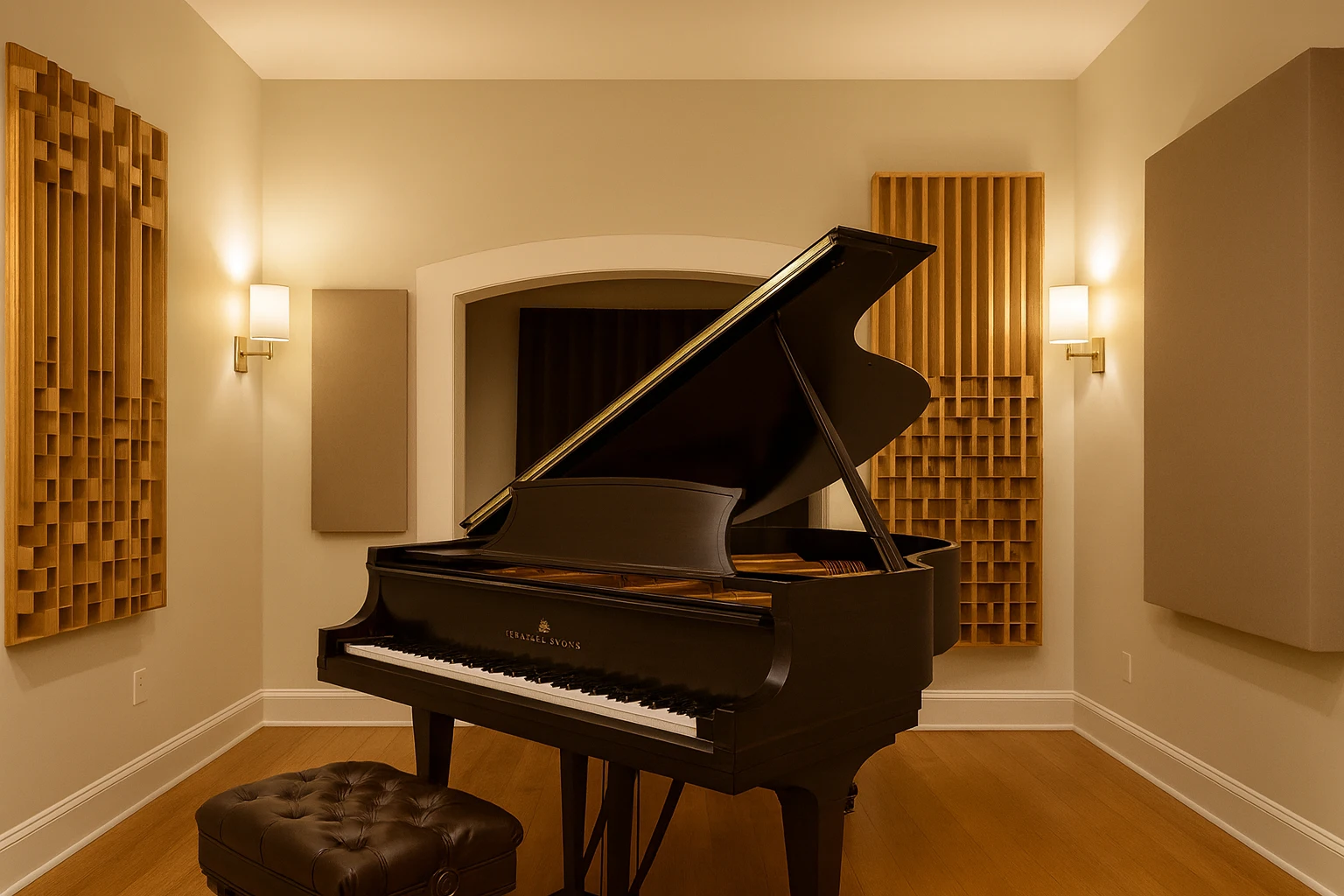


.svg)